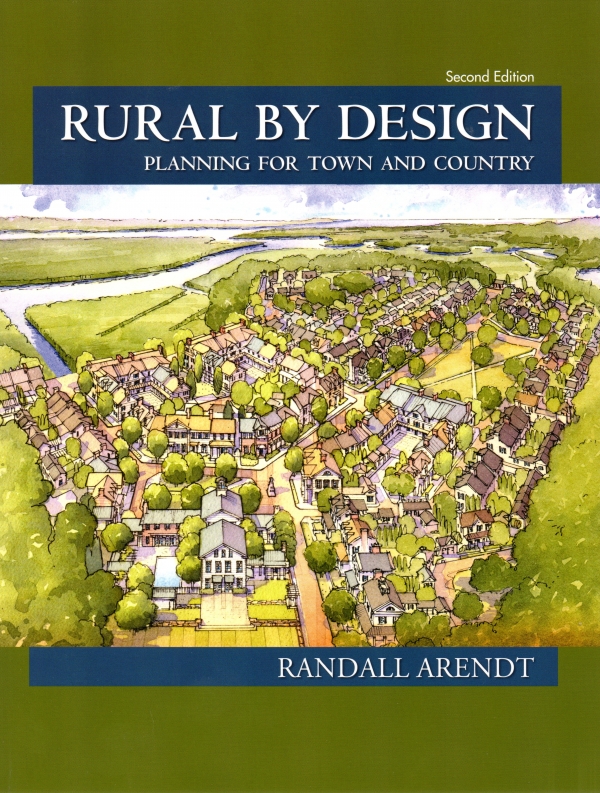How do you create attractive and environmentally sustainable places? A new, updated edition of a major text provides powerful lessons and evidence.
The first edition of Randall Arendt’s Rural by Design was published 20 years ago, and became a classic resource for a generation of planners and urbanists in North America. The new edition is even better, and has an international relevance, despite remaining rooted in the planning and development context of the USA.
Arendt makes a persuasive case that a study of traditional towns reveals some time-tested principles that were lost in the second half of the 20th century, as suburbs spread and a routine land use zoning system set the template for layouts. However, the book is no whimsical hymn to a bygone age. The new edition embraces very 21st century concerns such as low impact development, the role of green infrastructure networks, and how to redevelop commercial corridors, to list just a few examples.
Rural?
The book’s subtitle „Planning for Town and Country“ gives a better indication of the contents than the title itself. The author takes a broad definition of „rural“ and notes that „rural“ is a subjective concept. His contention is that many principles of rural design can work in towns and neighbourhoods. Green space – in all shapes, sizes and configurations – is integral to creating attractive and environmentally sustainable places. Thus, for example, when discussing traffic calming in residential neighbourhoods, he favours curved, even meandering streets, echoing natural landscape features, and argues for keeping the centreline radius in curves down to 72 feet (roughly 21 meters) if the aim is to slow car speeds down to 15-18 mph (roughly 25kph). Similarly, in residential streets, broad grassy areas separating paving from the road can dispense with the need for curbs and allow stormwater to seep into the ground as it does alongside traditional rural roads.
Chapter 8, „Blending New Urbanism with Greenway Planning and Conservation Design“ distills the philosophy that infuses the whole book. It begins „Creating greenway networks for informal recreation, exercise and enjoyment of nature is perhaps the most fundamental element of enlightened town planning, whether in rural, suburban or urban locations“. Green corridors are fundamental to „civilized, healthful community design“; and good quality green space design pays dividends to developers prepared to use it.
Design begins with understanding and respecting the natural environment: preserving major tree groups, for example, rather than clearing them to create a „blank sheet“ for new development. The book illustrates the many ways (successful and unsuccessful) in which houses can be laid out adjacent to green space.
Gateways and Corridors
Commercial strips fronting the highways are a typical feature of US towns. When I see them, I always puzzled by just what difference a century of planning has made. Set back behind asphalt parking lots, and often without „sidewalks“, trees, or anything to compete with the commercial signage, they are hostle environments, negotiable only by cars and trucks. Yet they seemingly tick all the regulatory boxes imposed by the local planning systems. Arendt’s explanation is that „the scale, pattern, design, and location of new buildings and parking areas are scarcely addressed in most land use regulations“.
How can these 20th century dinosaurs be replanned? Happliy many were short-term investments, with short design-lives, often only 25 years, and the advent of e-commerce may accelerate their demise. Getting buildings to be more than a single storey and to front on to the street, with parking at the rear, should be a basic requirement. A more provocative planning instrument that civic organisations might be tempted to use is a „Map of regrettable buildings“, such as the one produced by urban design students in Northampton, Massachusetts, and which the book illustrates.
A Wealth of Practical Examples
It is impossible adequately to summarise the comprehensive scope of this 525 page blockbuster in a short blog such as this. Suffice to say that it is crammed full with practical examples, and illustrated by a multiplicity of colour photos, maps and layouts. The American Planning Association, the publishers, have produced a handsome volume in which the visuals do justice to the clarity and flow of the writing. The book exudes a deep professional understanding of how to design and manage the physical environment in all its aspects. It synthesises an enormous amount of practice from across the USA, piecing together research findings and local examples. Reading it is like being taken on a classic American road trip by an expert guide who stops off at numerous places, interprets them for you, and leaves you the photos to take home and use afterwards.
Here in the UK, the chronic under-provision of housing in areas of high demand has created a „numbers“ mentality, obscuring important questions about the quality of the living environments that are to be created. Randall Arendt’s book should be a reminder to planners and designers that conservation-inspired design can deliver places that people want to live in, streets where children can play safely, businesses can operate successfully, and ecosystems that are in a healthy condition. It’s what is now being called „place-making“, though that phrase is only used obliquely by Arendt, when summarising others‘ recommendations. For those of our generation it was just „planning“.

Schreibe einen Kommentar